|
1) THE PRESIDENT'S CORNER (by Tom Steichen)
 This
month's random bits and pieces (Article 1) begins with repeats of
requests for assistance, that being from the historian commissioned to create the 750th
anniversary volume for the municipality of Großpetersdorf and the 4 villages that are
part of it, Welgersdorf, Kleinpetersdorf, Kleinzicken and
Miedlingsdorf, and from a Master's student at Vienna University, who is doing a
research survey. I believe these are worthy projects that need your support. We follow
with the continuing saga of Austrian SPÖ politics... things are happening! Then we
provide an update on the Neusiedlersee water crisis in northern Burgenland. In the
fourth bit, we talk about an update to our recipes page. The last bit recounts some history,
but with a document to make it real. This
month's random bits and pieces (Article 1) begins with repeats of
requests for assistance, that being from the historian commissioned to create the 750th
anniversary volume for the municipality of Großpetersdorf and the 4 villages that are
part of it, Welgersdorf, Kleinpetersdorf, Kleinzicken and
Miedlingsdorf, and from a Master's student at Vienna University, who is doing a
research survey. I believe these are worthy projects that need your support. We follow
with the continuing saga of Austrian SPÖ politics... things are happening! Then we
provide an update on the Neusiedlersee water crisis in northern Burgenland. In the
fourth bit, we talk about an update to our recipes page. The last bit recounts some history,
but with a document to make it real.
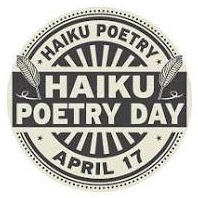
Because National Haiku Poetry Day is observed annually on April 17, I also present this
month's topics in Haiku format, a form of Japanese poetry that can be non-rhyming and usually
consists of 3 lines with a syllable pattern of 5-7-5. Please forgive my feeble efforts:
|
Junk in a drawer
Is history to a village,
But you must share it.
|
What once was left is
Quickly becoming rightist;
Politicians change.
|
The Neusiedlersee
Was home to herons they say;
Salt-sand blows away.
|
Ethnic Recipes...
The page has been updated.
Print them if you wish.
|
Terror, White or Red,
Doesn't matter if you're dead.
How 'bout jail instead?
|
Facebook chats away
As people have much to say.
Will you join today?
|
It's not a poem.
It's just seventeen words of
A business ad.
|
She had three kind sons
Who ran afoul of Nazis.
Yes, had three kind sons.
|
Music to our ears,
Ethnic dance steps for our feet.
Coplay Sängerbund.
|
He died in Jersey
But was born in Burgenland.
Both states are crying. |
Our regular tidbits include the monthly BB Facebook report, book
sales, a recipe (you should consider providing one too!) and some words for thought.
The remaining articles are our standard sections: A Historical BB Newsletter
article, Ethnic Events and Emigrant Obituaries.

 Großpetersdorf
750th Anniversary Book: I recently received a request from Dr. Gerhard Baumgartner, a
historian from Vienna. He said that the municipality of Großpetersdorf will soon be
celebrating the 750th anniversary of its first documented existence, so wants to publish a
history of Großpetersdorf and the four villages belonging to it:
Welgersdorf, Kleinpetersdorf, Kleinzicken and
Miedlingsdorf. He has been commissioned to put together this volume (I have confirmed
this) and is looking for documents and photographs of all kinds of things relating to either
the history of the villages or the families that left for the USA, Canada, and South America. Großpetersdorf
750th Anniversary Book: I recently received a request from Dr. Gerhard Baumgartner, a
historian from Vienna. He said that the municipality of Großpetersdorf will soon be
celebrating the 750th anniversary of its first documented existence, so wants to publish a
history of Großpetersdorf and the four villages belonging to it:
Welgersdorf, Kleinpetersdorf, Kleinzicken and
Miedlingsdorf. He has been commissioned to put together this volume (I have confirmed
this) and is looking for documents and photographs of all kinds of things relating to either
the history of the villages or the families that left for the USA, Canada, and South America.
He tells me that he has, so far, concentrated on finding relevant material in the Hungarian
archives, but he soon realized that the material about emigration is especially weak. He went
on to note that this especially true for Welgersdorf, a place where he has been led to believe
had many migrants to the US—apparently about 400—but he says it is a lot of rumors with very
few hard facts and very few photographs.
Therefore, he is requesting its emigrants and the descendants of its emigrants to provide
documentary materials, both for Welgersdorf and the other villages in the municipality. If you
have ancestral items related to the municipality... village and/or emigrant photos, passports,
travel documents, heirlooms, diaries, emigrant/emigration stories, etc., please consider
sharing these. Dr Baumgartner states that, "All materials will be archived digitally at the
city hall. If the owner agrees, some will be published on the city homepage and in the printed
volume in September. Owners of published materials will get a free copy of this book."
From this, it is evident that you will retain your original items and copyrights, as only
digital copies will be used in this project. And given that digital is how this will be done,
it is extremely important that the scans and photos be of as high quality as
possible.
Dr. Baumgartner's email address is
gerhard.baumgartner57@gmx.at. Please reach out to him for more details if you believe you
have materials of interest for this project.
This is a project for which I strongly encourage you to respond if you have
appropriate materials!

 Vienna
University Student Needs Interview Subjects: Nikola Blagojevic, a Master's candidate
at Vienna University in the Department of Social and Cultural Anthropology,
needs digital interview subjects for a class project regarding Burgenland's natural
environment. I have confirmed that he is, in fact, a student there and that this is a
legitimate request. Therefore, I am asking you to assist him by participating. I will present
his request then add a few additional comments. Vienna
University Student Needs Interview Subjects: Nikola Blagojevic, a Master's candidate
at Vienna University in the Department of Social and Cultural Anthropology,
needs digital interview subjects for a class project regarding Burgenland's natural
environment. I have confirmed that he is, in fact, a student there and that this is a
legitimate request. Therefore, I am asking you to assist him by participating. I will present
his request then add a few additional comments.

Nikola writes:
Dear BB members! I am a student at the University of Vienna conducting research on the
Perception of the Environment at the National Park Neusiedlersee-Seewinkel for my
ethnographic course. The research also encompasses the perception of the general environment
of Burgenland. Due to the intended digital methodology of this project, I wish to talk via
email with people from the United States who are affiliated with the Burgenland ecosystem in
some way.
As we know, nature is almost always intertwined with our lives, so I would like to hear about
your personal experiences or family stories related to Burgenland. In order to achieve this, I
have prepared a number of questions that can be answered by email. Of course, if there are
other things you would like to add or talk about in relation to Burgenland's environment,
please do so. My email address is niko.bvic@gmail.com.

Editor: Nikola's project centers on the Neusiedlersee and the
Seewinkel (but also includes the whole of Burgenland). Still, he has special
interest in those of you who are familiar with this part of Burgenland. He also has special
interest in BB members who live in Burgenland or frequently visit it. If you fit these
categories, please strongly consider responding. Nonetheless, participation by people
interested in other parts of Burgenland are needed.
Nikola has prepared nine questions, shown below, that he asks you to respond to. Please copy
these questions, paste them into an email, then provide written responses. Nikola provides
some guidance on the level of detail desired but you may respond as you see fit. Your
responses should be sent to: niko.bvic@gmail.com.
Nikola may have follow-up questions to clarify or expand answers.
(If you are unable to move the questions to an email, just write to Nikola and
ask him to provide them directly in an email.)
Also, according to data privacy laws and school policy, Nikola is required to obtain written
consent from each interviewee to be able to use your data, thus you will need to give your
consent. The University of Vienna provides a standard consent page and corresponding
privacy notice for this purpose, which I have translated to English. You can read them here:
Consent/Privacy. However, it is sufficient merely to acknowledge
that you have read and agree to these documents, so a one-sentence "consent to use data" has
been added to the bottom of the questions. Please fill in your name in the space provided and
send it with your answers when done.
Again, I strongly encourage you to respond.

Questions:
Part A: Please provide brief answers to these questions:
1. What is your relationship to Burgenland? That is, are you an emigrant or a descendant of an
emigrant, and, if so, when did the emigrant emigrate and from which village?
2. Why did you or your ancestors migrate to the US?
3. Have you ever visited Burgenland? If so, which parts and when?
4. What do you like the most about Burgenland?
Part B: Please provide moderate answers to these questions:
5. Please share any stories about Burgenland regarding its lifestyle and, if possible, about
the environment, either in the past prior to migration or in the present. For example, your
family stories and experiences.
6. Do you have any contact with any of the Burgenland residents today? If so, do you talk
about life and the environment in Burgenland? If so, please describe.
Part C: Please provide extended answers to these questions:
7. Taking into account the aforementioned questions about family history and life in
Burgenland, would you say that you feel connected to nature in Burgenland - in the
sense that you are familiar with how people perceived the environment and the role it played
in their lives, both past and present?
8. Do you know how people in Burgenland take care of their natural habitats? If so, please
describe.
9. Are you aware of how nature affects people, and do you know how they perceive the
environment in Burgenland today and in the past? For example, agriculture, economy, climate,
wildlife, tourism, water, and biodiversity. Please describe.
Consent to use data:
I (place your name here) have read the consent form and privacy
notice provided by the University of Vienna and hereby give my consent to use this
interview data under the conditions described.

Austrian SPÖ Politics: A decision has been made that the members of the Austrian
SPÖ party were to be surveyed over the period April 24 to May 10 (so no results are yet
available). The survey asks who should head the federal SPÖ party in the future, with
current party leader, Pamela Rendi-Wagner, and Burgenland Governor, Hans Peter Doskozil, being
the headline candidates.
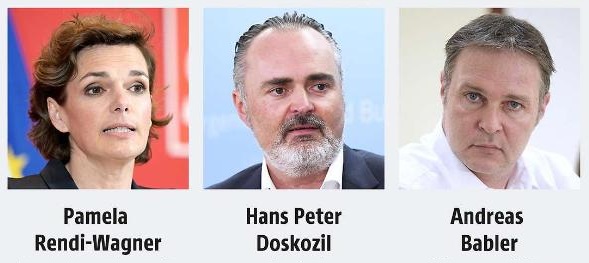 While
there were 73 total applicants, only Andreas Babler, the Mayor of Traiskirchen, Lower Austria,
proved viable (and he is likely only trying to earn name recognition on the national stage
this time around). The other candidates could not get the required 30 declarations of support,
were not party members, or failed to follow-up with the election committee. While
there were 73 total applicants, only Andreas Babler, the Mayor of Traiskirchen, Lower Austria,
proved viable (and he is likely only trying to earn name recognition on the national stage
this time around). The other candidates could not get the required 30 declarations of support,
were not party members, or failed to follow-up with the election committee.
Nonetheless, a third candidate adds confusion as to what will constitute a "win" in the
survey. When it looked as if only Rendi-Wagner and Doskozil would enter the race, there would
almost certainly have been an absolute majority for one of the candidates, Now, with
three choices, it could well be that no candidate gets an absolute majority. Will a
plurality be enough for a candidate, or even the party as a whole, to consider it a win?
Doskozil's declared goal is to reach first place in the survey and has said his candidacy
rides on a survey win. Rendi-Wagner has said she wants to leave politics if not confirmed by
the party membership. How the candidates eventually define win or confirmed will
be interesting.
Austrians had until Friday, March 24, to becomes a full member of the SPÖ, which was
the prerequisite to vote. For this, you had to be at least 16 years old, not belong to any
other political party, commit to the principles of the party, and pay the monthly membership
fee of 6.50 euros.
As for the survey, party members are able to vote either by letter or electronically on who
should lead the party in the future, with the first question being whether Pamela Rendi-Wagner
should remain party leader and top candidate. Only then will additional questions
address Hans Peter Doskozil and Andreas Babler as to their party function.
Despite the comments of the leading candidates that they will honor the results of the survey,
the statutes of the SPÖ party do not allow the party executive committee
to be determined by member survey. Therefore, the party delegates are to confirm the result at
a special party congress on June 3. And, because anyone who wants to compete at the party
congress can do so regardless of the result of the member survey, an uneventful party congress
cannot be assumed.
What is known about the SPÖ members and their desires? Most recently, there were around
140,000 members (down from nearly 160,000), but that number rose to nearly 148,000 given the
interest generated by the survey. It is known that eastern Austria was much more represented
than western Austria in the SPÖ, with an average member age about 63. In the last
survey (in 2020), it became clear that health care, wealth taxes and secure pensions were
particularly important to SPÖ members. However, Traiskirchen Mayor Babler is the one
and who is attracting new, younger members to the party, with people saying they are
joining the party specifically for him. He is particularly popular with the left-wing of the
party. Rendi-Wagner remains popular with the Viennese party and women's organizations.
Doskozil draws supporters from Burgenland, Styria and parts of Lower Austria.
As for the chances that Rendi-Wagner, Doskozil and Babler would have in a National Council
election, the pundits say it is likely that Rendi-Wagner could keep more people who
cross-voted for the SPÖ in 2019 and attract more new votes from the leftist Neos
and Greens than Doskozil could. But they also say that Austria is a structurally
conservative country, so a center-left candidate also has to attract center-right
votes, which is where Doskozil would excel. Babler is on the far left end of the SPÖ so
less likely to attract center-right votes... but, being left of Rendi-Wagner, he could attract
even more Neos and Greens for the SPÖ. Both Doskozil and Babler had
campaign tours around Austria touting their platforms; Rendi-Walker did not.
There was one small surprise when the survey was published: A fourth option was added to the
ballot, that being "None of the candidates mentioned." The explanation given for this
was that the survey can be done via digital or mail-in paper ballot. Paper ballots could be
returned with no candidate selected but the digital ballot required a selection... this
removes that difference.

New Neusiedlersee Water Commission: A Water Level Commission for Lake
Neusiedl has been founded by the Burgenland state government. It is to meet weekly to discuss
possible problems due to the low water level and to establish and run an "early warning
system" to monitor water level and quality and impose restrictions, if necessary, on the use
of the lake. The commission consists of representatives of the state administration, the
district administrations of Eisenstadt and Neusiedl am See, the national park, the state
security centre and tourism. The aim is to preserve the lake as a habitat and water surface.
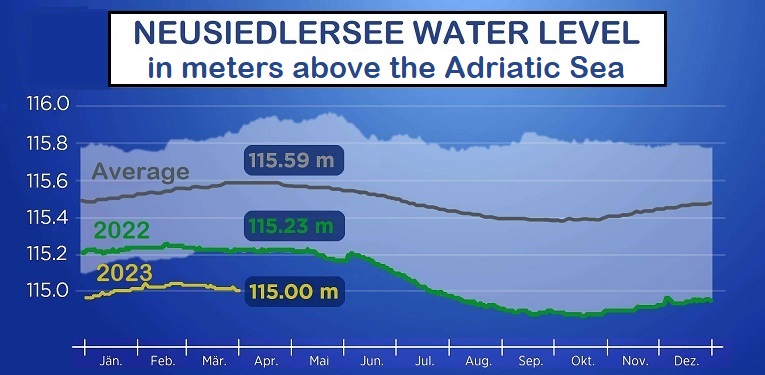
Neusiedlersee Water Level for Early April:
Water level was 0.59 meter (23+ inches) below average for that time of year and 9 inches below
the level of one year ago. The normal trend suggests the level will fall another 8 inches
toward a typical low in September or October.
It is clear to the Commission and others that more water is needed for the lake, for
the groundwater in the Seewinkel, and for the paints. An initial solution via the Hungarian
Moson Danube is still being examined but has stalled somewhat in Hungary. No EU funds have
been awarded and national funding is not currently available in either country. However, talks
are ongoing. At least one solution through Lower Austria is already off the table due to its
route through the national park area and concerns of the province of Lower Austria about its
drinking water supply. A supply line via the Einser canal is also being considered where water
from the rivers Ikva and Raab would be dammed and pumped into the lake via the canal but this
would involve the Hungarians too.

 Recipe
Page Update: The BB managing staff, over the last few years, has been making small
changes to web pages to make them display better on mobile devices, especially on phone
screens (while also maintaining most of their usual appearance on lap- and desk-top
computers). The reality is that many of our pages are data-intense and, therefore, difficult
to display usefully in small formats. Still, there are some pages that are effective on
small-screen displays, especially if you view our pages in landscape mode (landscape
is the default for the “regular” computers we designed our pages for, so it also proves to be
better on phones). Recipe
Page Update: The BB managing staff, over the last few years, has been making small
changes to web pages to make them display better on mobile devices, especially on phone
screens (while also maintaining most of their usual appearance on lap- and desk-top
computers). The reality is that many of our pages are data-intense and, therefore, difficult
to display usefully in small formats. Still, there are some pages that are effective on
small-screen displays, especially if you view our pages in landscape mode (landscape
is the default for the “regular” computers we designed our pages for, so it also proves to be
better on phones).
The Recipes page is one that has received recent attention, both for
mobile-friendliness and to give it a facelift with a more modern font and some new features.
It now displays well on tablets and mobile phones, where the menu has been condensed
into the hamburger icon seen on many other websites (click the hamburger and the
menu bar will display).
There is also a new menu link called Recent Recipes that will take you to the
bottom of the page, where the latest newsletters are found. A related addition is a Back to
Top button in the lower right of the page. As you scroll down, or if you use the Recent
Recipes link, this button will appear and allow you to get back to the top of the page
without having to manually scroll all the way back up.
As before, the columns can be sorted, but they have been updated. While NL#
(newsletter number) remains the default sort column, Food Categories has been
reworked into Keywords so that similar recipes are more easily grouped together. Just
click that column heading.
The final change is the addition of a printer icon next to some of the
newsletter numbers. If you see a printer icon by a newsletter number, clicking on the
newsletter number will cause the recipe to display as a stand-alone page that you can
print or save to a PDF file, so you won't have to cut-and-paste to format a recipe for your
collection! Eventually, all recipes will have stand-alone pages but, until then, newsletter
numbers without a printer icon will take you directly to the recipe section
of that newsletter and you'll have to figure out how to print the recipe yourself.
We welcome any feedback on these changes. Please send any comments to
BB Recipes Editor, Alan Varga, who is credited with
this update. Thanks Alan!

Interesting Bit Of History: Richard Potetz shared with me a document that had
been sent to him by Ferenc Zotter. Ferenc told Richard that the National Archive of Hungary
had published materials about persons registered by the National Police for so-called
anti-state activities after the First World War, and he had found a person named József
Potetz among them.
Richard, of course, wondered if that person was his same-named grandfather, Josef Potetz
(1877-1964). He was pleased to learn that the details of the record exonerated his
grandfather, as grandfather was still a prisoner of war in Siberia when this József was sent
to prison. Richard also went on to explore the ancestry of the convict and found no tie to his
own line, at least as far back as 1789. Thus, he claims, "So far, my ancestry finds no
convicted felons."
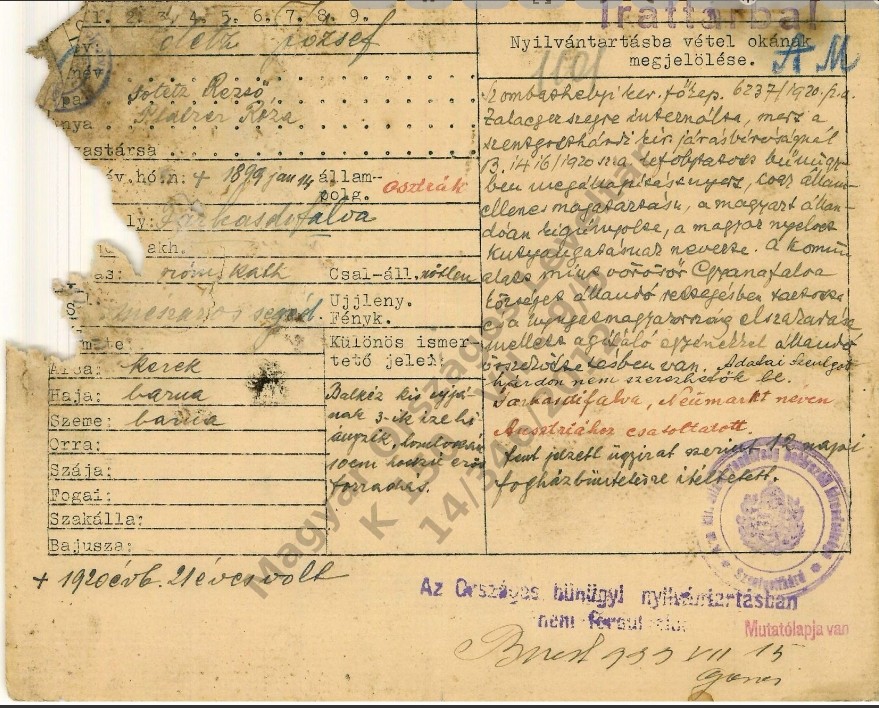 While
the above is interesting in its own right, the document allows me to include some
substance in a short discussion of what happened in Hungary between the end of WW-I and the
transfer of Burgenland to Austria in 1921... and, since Richard gave me permission to use the
document, I'm pleased to do that! While
the above is interesting in its own right, the document allows me to include some
substance in a short discussion of what happened in Hungary between the end of WW-I and the
transfer of Burgenland to Austria in 1921... and, since Richard gave me permission to use the
document, I'm pleased to do that!
So, I've included here a thumbnail of the document that, if you click it, will give you access
to a higher resolution image. But I've also included a translation of the document below,
roughly laid out how the original appears. While I have more to say, I'll let you read the
document first then give the relevant, contemporaneous background.
But I also must give credit where due: Ferenc Zotter provided Richard with the document and a
partial translation. But, knowing I intended to use it here, I wanted a complete transcription
and translation. While I did one of my own, I also asked Julia Szent-Gyorgyi to translate it
for me so I didn't miss any details. Thus most of the credit for the document must go to
Ferenc and Julia! Thanks, you two!

Name: Potetz József
Father: Potetz Rezső
Mother: Platzer Róza
Birth: + 1899 Jan 14
[Ed: 15 per birth records]
Citizenship: Austrian
Birthplace:
Farkasdifalva
Religion:
Rom. Catholic
Marital Status: Single
Occupation: Assistant
Butcher
Face: Round
Hair: Brown
Eyes: Brown
Unusual ID marks: Left
hand pinky finger's 3rd joint missing, forehead has 10-cm-long prominent scar |
Indication of Reason for Registration
Regional chief captain of Szombathely under number 6237/1920 interned him at
Zalaegerszeg because, in the case conducted before the royal district court of
Szentgotthárd under number B.1415/1920, it was determined that he has an anti-state
attitude, he constantly ridiculed Hungarians, and he called the Hungarian language
the barking of a dog. Under Communism as a Red Guard, he kept the community of
Gyanafalva in a constant state of terror, and he is in constant contact with
individuals agitating for the secession of western Hungary. His data could not be
obtained in Szentgotthárd.
Farkasdifalva has been attached to Austria under the name of
Neumarkt [an der Raab].
Per the above-indicated case file, he has been sentenced to 12 days imprisonment. |
| + was 21 years old
in 1920 |
Does not appear in the national criminal
register.
Has index card. |

So what was happening in Hungary after WW-I? As you know, the Austro-Hungarian Empire
was on the losing side of the war and the victorious Entente powers took steps to carve
out Hungary's ethnically mixed border regions and grant them to newly-created states based on
their ethnicity (usually defined by language), even to the extent of transferring hunks of
historical Hungary to these new countries because of the majority language spoken there.
Hungary lost two thirds of its land area and one third of its Hungarian-speaking nationals in
this process.
Hungary, itself, was in disarray after the war and on October 31, 1918, the Hungarian
Democratic Republic, with Mihály Károlyi as the republic's Prime Minister was created by
revolution to declare the independence of Hungary from Habsburg monarchy rule. But it did not
last long.
Another revolution in early 1919 marked the end of this state and the creation on March 21,
1919, of a new communist state known as Hungarian Soviet Republic, led by Béla Kun.
This government had garnered support, not because of its revolutionary agenda but because it
declared it would restore Hungary's borders. Nonetheless, it proclaimed a dictatorship of
the proletariat, nationalized industrial and commercial enterprises, and socialized
housing, transport, banking, medicine, cultural institutions and all landholdings of more than
100 acres.
While Kun hoped that the Russian government would quickly prop up his government, in the
interim he resorted to arbitrary violence to secure its rule. Paramilitary Red Guard
groups were established and tribunals, as part of the Red Terror, ordered about 590
executions of anti-communist forces and others deemed to be enemies of the state, including
clergy.
In late May, Kun attempted to fulfill his promise to restore Hungary's borders and the
Hungarian Red Army occupied part of Slovakia. Kun was quickly forced to withdraw when the
French threatened to intervene, so he turned his army on the Romanians. The Romanians broke
through the Hungarian lines on July 30, occupied Budapest, and ousted Kun's Soviet Republic
on August 1, 1919. It had lasted just over four months, a few days less than the government it
had replaced.
A new government, formed by Social Democrats and controlled by union leaders, replaced
it but lasted only a few days. It was followed by a right-wing, counter-revolutionary group
backed by the Royal Romanian Army. With the King of Romania's approval, Prince Joseph
August (of Hungary and Bohemia and Archduke of Austria) declared himself regent of
Hungary and appointed István Friedrich as Prime Minister. However, the Allies
refused to recognize the new government and the Romanian army decided that it was not willing
to protect it.
Meanwhile, military leaders in the south of Hungary formed an alternative government. Its
armed wing, called the National Army, was led by Miklós Horthy, a former Admiral of the
Austro-Hungarian Navy. Among his officers were ultra-nationalists who mounted a campaign of
atrocities in retaliation for the Red Terror, and to eliminate communist supporters and
frighten the population into obedience. Paramilitary organizations were also formed during
this nationalist Hungarian Awakening and became known as the White Guards. Both
the National Army and the White Guards carried out a campaign of murder,
torture, or humiliation in the south and east against anyone who was considered an enemy of
the state, including communist supporters, peasants, the politically liberal, and the Jews,
who were blamed for the previous communist repression. This quickly was dubbed the White
Terror.
The National Army invaded Budapest in November 1919, driving out the Prince Joseph
August government, and Horthy became regent of the newly established Kingdom of
Hungary. Rather than discontinuing their campaigns, the White Guard units expanded
and continued terrorizing their targets for almost two more years.

Now it is time to return to József Potetz and his problems. While we have to guess at
the exact timing of things, we know from the report that he was sentenced and sent to prison
in 1920. Further, since the report declares he was a Red Guard under the Communist
government, he must have been terrorizing Gyanafalva (Jennersdorf) in the March to July 1919
period. Sometime thereafter—and long-enough thereafter that he could be accused of having "an
anti-state attitude" (against the then-current government), to "constantly ridicule"
the Hungarians and be "in constant contact with individuals agitating for the secession of
western Hungary"—he was arrested and presumably jailed awaiting his court appearance.
In many respects, he was lucky that he was on the western edge of Western Hungary, where he
was only arrested. Given his Red Guard status and his ridicule of nationalist
Hungarians, he likely would have been murdered or tortured had he carried out his activities
elsewhere in Hungary. And really, 12 days in an actual prison was just a slap on the wrist.
Given the police report notes that "Farkasdifalva has been attached to Austria under the
name of Neumarkt," the date of the last entries in this file clearly were after August 28,
1921, the date of Burgenland's official transfer to Austria. Whether the file was ever shared
with Austria is unknown and I could find nothing further about József.

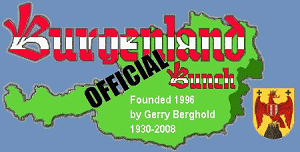 The
Facebook Bunch (from Vanessa Sandhu): The
Facebook Bunch (from Vanessa Sandhu):
Greetings, Burgenland Bunch!
I hope that this message finds you well! We had a great time in our Facebook group this
month. Our membership count stands at 2020. We had lots of new content shared, so stop on by
and check it out!
facebook.com/TheBurgenlandBunchOFFICIAL
Member Martha Orlovits shared an album containing almost 130 photos of the
memorials at Cemetery Glashütten bei Langeck, located in Lockenhaus, Oberpullendorf.
Member Sandra Simon Perkin shared a fun link regarding the Burgenländisch
dialect:
youtube.com/watch
Member Janet Kroboth Weber shared a link featuring lots of traditional folk
songs for you to enjoy!
youtube.com/watch?Z. Janet also shared a great link about Burgenland’s Blaudruck
printing technique.
bbc.com/travel/article/blaudruck
Member Franz Stangl shared many photos and videos showcasing the Palm
Sunday, Good Friday, and Easter celebrations in Güssing.
BB Staff member Bob Strauch shared a link to a story about the beautiful
Easter eggs crafters in Stinatz.
burgenland.orf.at/3201275
Member Johann Hammer shared an interesting resource called Topothek. He
writes “I would like to draw your attention to an interesting source of historical photos
from private sources: topothek.at. The Topotheque is
a platform which makes local, historical relevant material and knowledge, that is kept in
private hands, accessible online, in cooperation with the local population. Unfortunately,
there are only a few Topotheques from Burgenland: Bad Sauerbrunn, Bocksdorf, Gattendorf,
Neudorf bei Parndorf, Neusiedl am See, Parndorf, and Sieggraben (menu item "Our Topotheques");
but maybe more places will be added in the future.” Hopefully this site will be of use to
some members!
topothek.at/en/
Member Christine Rubba shared some beautiful photos of the spring flowers
blooming now in Burgenland.
Member Martin Wolf shared a great clip of nostalgia from Castle Tabor in
Neuhaus am Klausenbach back in 1956. youtu.be/Cx
Some exciting events are coming up in May in the Lehigh Valley! The Coplay
Sängerbund’s Heritage Committee is pleased to announce their yearly Maifest! The
Maifest will be held on Sunday, May 7th, 2023 from 3:00-6:00 pm. Music will be provided by
Dave Betz. Join the party and dance around the Maibaum! A May Queen will
be crowned - don’t forget to wear your trachten! Admission is $5 for members and $7 for
non-members.
In addition to the Coplay Sängerbund’s upcoming Maifest, the venue will also be
hosting another awesome event! To celebrate their 75th anniversary, WMUH, Allentown
97.1 FM, will be presenting the Alex Meixner Band! On May 4th, 2023, Alex and his band
will make a homecoming. This is a very special stop for Alex, as he grew up in the Lehigh
Valley! His great grandfather, Leopold Meixner, was one of the founding members of the
Sängerbund. Alex’s musical family hails from Eisenberg an der Pinka. Alex has continued
the family tradition of making music and has been extremely successful. Alex has been
Grammy-nominated, and has also starred as the One Man Band in the Hormel Pepperoni commercial.
He also contributed to the soundtrack of the Jack Black movie “The Polka King.” Alex and his
band perform over 180 times a year across the United States, but this is a rare opportunity to
see him in Coplay, PA. Additional details: Cost of Admission: $20. Doors open at 5:30 pm,
music begins at 7:00 pm. The kitchen will be open and there is a cash bar for those 21 years
of age and older. Older traditional songs will be performed, and Alex will be taking requests!
Tickets can be purchased online at:
whennow.com/alex-meixner-band
CONNECTIONS:
Member Ron Schutzenhofer is looking for someone to take photos of grave
markers in Grafenschachen. If anyone is traveling to Grafenschachen or lives nearby and is
willing to assist Ron, please contact me at HooftyRN@msn.com
and I will be happy to connect you!
That’s all for now! Stay safe and healthy!
Vanessa

 Update
for book "The Burgenländer Emigration to America": Here is this month's update on
purchases of the English issue of the 3rd edition of Dr. Walter Dujmovits' book "Die
Amerika-Wanderung Der Burgenländer." Update
for book "The Burgenländer Emigration to America": Here is this month's update on
purchases of the English issue of the 3rd edition of Dr. Walter Dujmovits' book "Die
Amerika-Wanderung Der Burgenländer."
Current total sales are 1719 copies, as interested people purchased 2 more books during this
past month.
As always, the book is available for online purchase at a
list price of $8.89 (which is the current production charge for the book, as we
purposely choose not to make a profit so we can avoid dealing with the income tax
consequences and so you can obtain the book at as low a cost as possible!), plus tax &
shipping. Unfortunately, the price above is somewhat higher than in previous months, as our
on-demand publisher, Lulu, recently raised is printing prices by 9.5%, meaning we must
charge more. See the BB homepage for a link to the
information / ordering page and for information about current discounts (there is at least one
discount on price or shipping available most of the time... if not, wait a few days and there
will be one!).
The book is an excellent read for the Burgenländers in your family.

Burgenland Recipes: This recipe comes to us from
Kathy Shearrer. Her great-grandmother, Amelia Unger Mulitsch, was born in
Strem, Austria (then Hungary) in 1884. She came to the US in 1903 and married Ignatz Mulits
from Sumetendorf (Szombatfa), then settled in St. Louis, Missouri and had seven children, the
oldest of which, John Mulitsch, was Kathy's grandfather.
Kathy's sister, Jane Kolar, made this cake for her sisters a while back and Kathy assures us
that it is delicious; it is a dense cake with a thick caramel frosting.
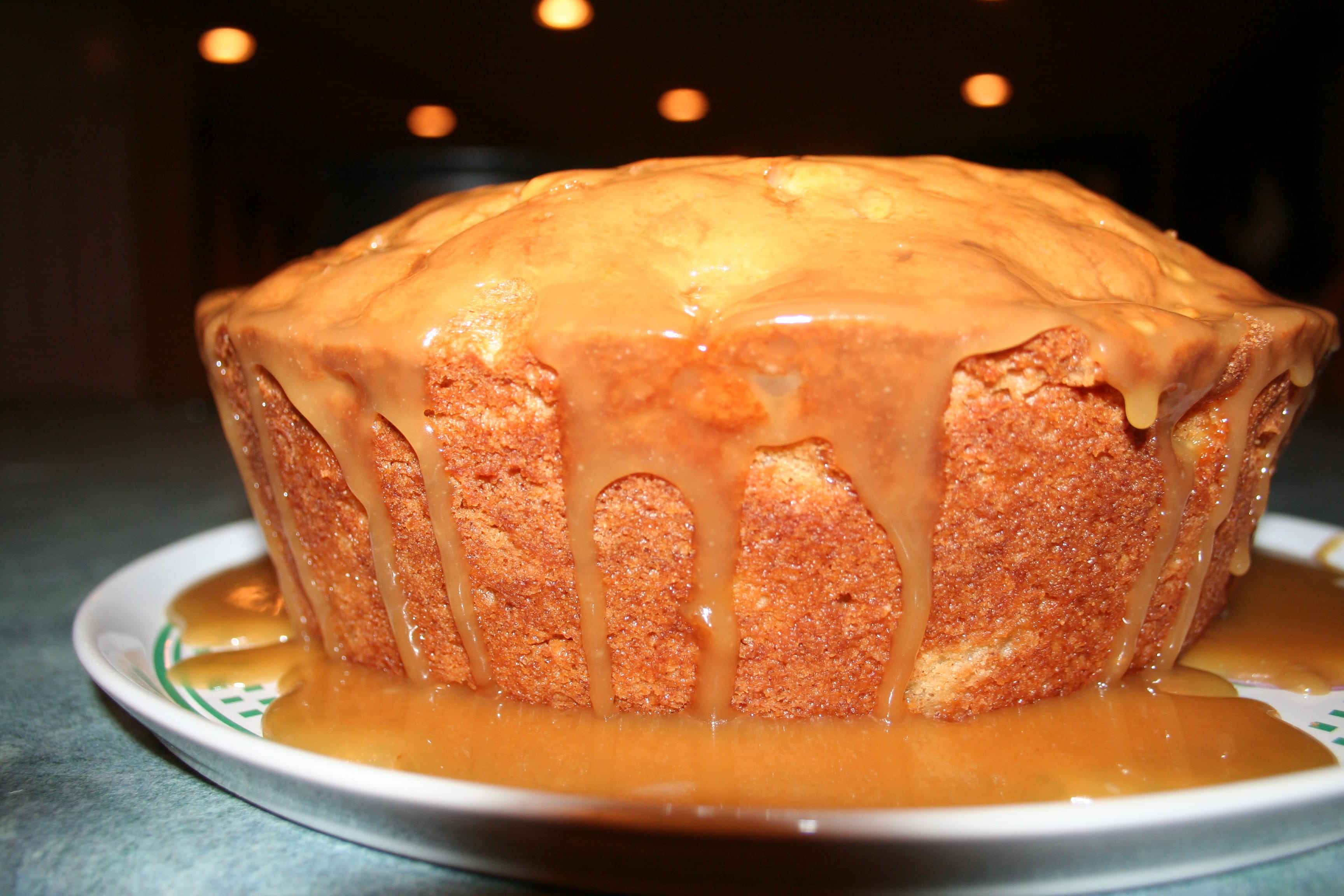 Nine Eggs Cake
Nine Eggs Cake
(from Kathy Shearrer)
Ingredients-cake batter:
- 9 eggs, separated
- one lemon (for zest and juice)
- 2 cups of sugar
- 1-1/2 cups of flour
Preparation-cake:
- Separate the eggs and preserve both the yolks and the whites.
- Grate and save the lemon zest.
- Squeeze and save the lemon juice, dividing it into two halves.
- In a large bowl, beat the egg yolks well and add half of the lemon juice. Add sugar,
then flour, then lemon zest.
- In a small bowl, beat the egg whites until they foam (but are not stiff) and add the
other half of the lemon juice.
- Fold the beaten egg whites into the batter in the large bowl.
- Line the bottom of a 9" spring-form pan and lightly grease the sides. Pour in the
batter.
- Bake for 35 minutes at 350°F; test and make sure a toothpick comes out clean.
Ingredients-caramel frosting:
- 2 cups of brown sugar
- 1/2 cup sweetened cream
- eigroße butter (an egg-sized chunk of butter!)
- ~1 tsp vanilla or vanilla extract
Preparation-caramel frosting:
- Mix the brown sugar, cream and butter in a sauce pan.
- Add vanilla to taste.
- Cook for 10 minutes over medium-low heat (but hot enough to eventually form bubbles on
the surface), stirring frequently.
- Cool to barely warm and pour onto the cake.

 Note:
Our recipes sortable list has links directly to the recipes or
food-related articles published in our past newsletters. You can access the list by clicking
our recipe box (to the right). Thanks to the contributions of our members over the years, we
have quite a collection of Burgenland recipes, some with several variations. Note:
Our recipes sortable list has links directly to the recipes or
food-related articles published in our past newsletters. You can access the list by clicking
our recipe box (to the right). Thanks to the contributions of our members over the years, we
have quite a collection of Burgenland recipes, some with several variations.
However, whenever we use up our unpublished recipes, this recipe section will become dormant.
So, if you have a favorite family recipe, please consider sharing it with us. We will be happy
to publish it. Our older relatives, sadly, aren't with us forever, so don't allow your
favorite ethnic dish to be lost to future generations.
You can send your recipe to BB Recipes Editor,
Alan Varga. Thanks!

Words for Thought:
This is not a poem
Although it looks a little bit like one
from a distance.
It's just a few words
to say that some new shows
have been added
to my tour this year.
I shall not be reading this
at any of them
Because, as I mentioned
in the title,
this is not a poem.
Brian Bilston |
|
3) HISTORICAL BB NEWSLETTER ARTICLES
Editor: This is part of our series designed to recycle interesting articles from the
BB Newsletters of 10 years ago. This month I chose to rerun one that tells a story that
tugged on my heart-strings when I wrote it... and did so again when I reviewed it for this
section. Given that, I'll share it again. Do note that there were follow-up bits in
Newsletters 233 and 234. They do not change anything said in this piece, but they do add to
the tragedy of the times.

THE BURGENLAND BUNCH NEWS No. 231
April 30, 2013
MARIA HOFFMANN HOTWAGNER
Sometimes, in researching one thing, you stumble across something else that is quite
interesting yet mostly disconnected from the original research. Such is the case this last
month when I became involved with the research of BB Member Florence (Beebe) Hoffman.
She was searching for the death date of an aunt of her husband Walter F Hoffman. Said aunt,
Maria Hoffmann Hotwagner, was born in Mariasdorf, Oberwart, Burgenland (Mariafalva,
Hungary), on July 15, 1878. Maria was one of the 13 children (Johannes, Maria, Josef,
Aloysius, Adolf, Ferdinand, Raymund, Carolus, Albina, Robert, Albert, Raymund, and Theresia)
of Josef Hoffmann, born 1851, and Maria Mattis, who married Feb 22, 1876. Beebe's husband,
Walter, is the son of Albert.
What is also known about Maria Hoffmann Hotwagner is that she married Josef Hotwagner (born
Feb 21, 1873 in Mariasdorf) on Feb 4, 1902 in Mariasdorf. Then she and her husband emigrated
to Chicago, IL, arriving via Ellis Island on March 7, 1902 (the surname was listed as
Hodwagner). Their first child, Josef, was born in Chicago on August 2, 1902. The family
returned to Hungary in 1908, where their second child, Ferdinand, was born on July 16, 1908.
They went yet again to the US, now with their two children, arriving on May 18, 1909, and,
according to the US Census, were living in Chicago in 1910. However, at some point they
returned to Hungary again, where child number three, Adolph, was born March 10, 1919, in
Mariasdorf. Thereafter, it appears they remained in Hungary.
As Beebe tells me...
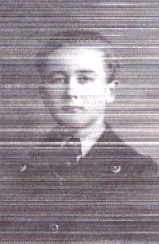 •
Son Josef Hotwagner was a teacher in Kitzladen, Austria, from 1928 until 1938. He died
in a prison hospital, July 3, 1945, in Straübing, Germany. •
Son Josef Hotwagner was a teacher in Kitzladen, Austria, from 1928 until 1938. He died
in a prison hospital, July 3, 1945, in Straübing, Germany.
• Son Ferdinand Hotwagner died in 1943, during WW-II, in Saljevo, Bosnia.
• Son Adolph Hotwagner died in 1944 in the Ukraine.
• She has no idea when Maria Hotwagner died, but...
• Maria's grandson, Josef Hotwagner, son of Josef, was the historian of Rechnitz, and
he died in 2010.
• No mention is made of the fate of Maria's husband, Josef Hotwagner.

I became involved with Beebe's research as a result of Angyne Smith's offer
(reported in last month's newsletter) to provide some research help to BB Members during a
trip she plans to make to Großpetersdorf this summer. Beebe responded, asking for a lookup of
Maria's death date but, to my eyes, her request message provided information that was both too
imprecise and too limited to expect Angyne to have any success. Beebe believed that Maria died
"in the 1900s" and "possibly in Rechnitz", which, as you can see, is a rather wide search
target for Angyne, so I started digging deeper and asking for more information. Most of the
information I present above comes from Beebe's replies and my personal research.
I recently passed along the (supplemented) request to Angyne ...but I also invite any of you,
who may recognize this family and know the desired death date, to drop a note to Beebe or me;
you'll make her day!
Now, though, we get to what the late radio personality Paul Harvey called, "the rest of the
story."

Almost a year ago, in BB Newsletter 221 (May 31, 2012), I wrote an article about
Burgenland's Castles. In it, I wrote (in part) the following about the Rechnitz Castle
(actually, a Schloß):
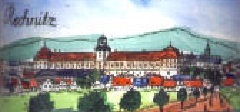 The
castle proper was completely destroyed when the Red Army overran the town and the
surrounding area during the night of 29 March 1945. Although the Russians were blamed for
setting the castle ablaze, many townspeople believe it was the German forces who torched it
in compliance with Hitler's scorched earth policy. The surviving private chapel suffered
the ignominy of being converted into a bar and other buildings into apartments. The
castle proper was completely destroyed when the Red Army overran the town and the
surrounding area during the night of 29 March 1945. Although the Russians were blamed for
setting the castle ablaze, many townspeople believe it was the German forces who torched it
in compliance with Hitler's scorched earth policy. The surviving private chapel suffered
the ignominy of being converted into a bar and other buildings into apartments.
In its last days, the castle also was the site of an atrocity. Margit Thyssen Batthyány-Strattmann
de Németújvár, daughter of self-styled "Baron" Heinrich Thyssen-Bornemisza de Kaszon, a
German entrepreneur and art collector, [and wife of Count Ivan Batthyány, a member of the
aristocratic family that once owned Rechnitz and the castle] received ownership of the
castle from her father in 1938. On 24 March 1945, with the Reds closing in, she hosted a
party for SS officers, Gestapo leaders, Nazi Youth and local collaborators at her castle,
during which nearly 200 Jews were shot by the attendees, apparently as after-dinner
"entertainment."
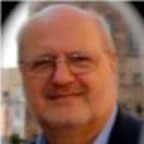 What
I did not know when I wrote that text, is that much of the atrocity story is known due to the
research of Maria's grandson, Josef Hotwagner, who was 8 at the time. As you might expect, the
participants in the atrocity did their best to cover it up. What
I did not know when I wrote that text, is that much of the atrocity story is known due to the
research of Maria's grandson, Josef Hotwagner, who was 8 at the time. As you might expect, the
participants in the atrocity did their best to cover it up.
 To
this day, the site of the final resting place of the bodies is unknown, though the shootings
took place at the Kreuzstadel (cross barn) on the edge of town, where a small group of
Jewish prisoners were forced to dig a large pit. Truckloads of additional prisoners were
brought there, forced to strip and kneel on the edge of the pit, then were shot in the neck by
party guests. The Kreuzstadel is now a monument to commemorate the massacre. However,
no mass grave has ever been found there, despite repeated research efforts. To
this day, the site of the final resting place of the bodies is unknown, though the shootings
took place at the Kreuzstadel (cross barn) on the edge of town, where a small group of
Jewish prisoners were forced to dig a large pit. Truckloads of additional prisoners were
brought there, forced to strip and kneel on the edge of the pit, then were shot in the neck by
party guests. The Kreuzstadel is now a monument to commemorate the massacre. However,
no mass grave has ever been found there, despite repeated research efforts.
As for the participants, only a few minor figures were ever convicted, in part because
witnesses were either killed or threatened.
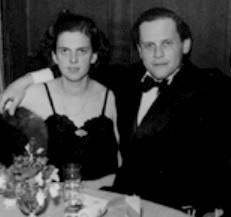 Margit
Thyssen, who died in 1989, skipped off to Switzerland immediately after, and insufficient
evidence has been produced to prove that she participated. However, her nephew, Sacha
Batthyány, who knew her well, titles her a "monster" and says she loved shooting and horses
over everything else, even her own children. Sacha also wrote that, although the massacre was
known of within the family, it was not a subject that could ever be discussed, especially
since Margit controlled the family fortune. Margit
Thyssen, who died in 1989, skipped off to Switzerland immediately after, and insufficient
evidence has been produced to prove that she participated. However, her nephew, Sacha
Batthyány, who knew her well, titles her a "monster" and says she loved shooting and horses
over everything else, even her own children. Sacha also wrote that, although the massacre was
known of within the family, it was not a subject that could ever be discussed, especially
since Margit controlled the family fortune.
[A side note: Ivan Batthyány, husband of Margit, was the son of Ladislaus Batthyány, eye
surgeon and benefactor. In last month's BB Newsletter, we noted that Ladislaus was beatified
by the Catholic Church in 2003 for his good works. In contrast, neither Ivan nor Margit were
allowed to be buried in the Batthyány family crypt at the Franciscan chapel in Castle Güssing,
which may also speak to what the family believed about them.]
Among those charged with organizing the massacre were SS-Hauptscharführer Franz Podezin, who
was the Gestapo administrator and leader of the Rechnitz Nazi Party, and Hans-Joachim
Oldenburg, a Thyssengas employee and Nazi Party member, who was assigned to manage the
Rechnitz estates but soon became Margit's lover, though that did not stop her from
occasionally bedding Podezin too. [Ivan Batthyány, her estranged husband, continued to enjoy
his wife's money and breed horses on another of the Batthyánys' Hungarian estates. However,
there have been claims that he was present at the party on the night of the massacre. He is
known to have joined his wife in Switzerland after the massacre, as they both fled the arrival
of the Russian Army.] Podezin is believed to have directed events on the evening of the
killings; Oldenburg, along with Podezin, is believed to have personally directed disposal of
the 18 prisoners who filled in the mass grave and were then confined in the local abattoir (a
fancy word for slaughterhouse); they were shot and buried the next evening. Those bodies were
found in 1966 in a field near the abattoir.
Because the main grave has never been found, activists have accused the citizens of Rechnitz
of a cover-up. However, it was by the efforts of Josef Hotwagner, as town historian, that most
of the facts were uncovered. But, one may ask why Josef Hotwagner (a schoolteacher like his
father), became interested in researching these events and exposing what occurred. The answer
lies in what was not said in the partial answer given by Beebe above, when she stated, "Son
Josef Hotwagner was a teacher in Kitzladen, Austria, 1928-1938. He died in a prison hospital,
July 3, 1945, in Straübing, Germany."

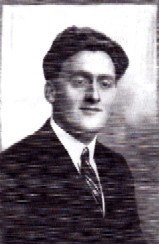 The
historian Josef Hotwagner, son of the Josef above, and Wilhelm Gregorich
(see below) report the story more fully... Josef's father was the head of the primary school
in Kitzladen until 1938, but was demoted several times thereafter by the Nazi regime, largely
because he could speak Hungarian, first to St. Martin and then to Schachendorf as a simple
teacher. The
historian Josef Hotwagner, son of the Josef above, and Wilhelm Gregorich
(see below) report the story more fully... Josef's father was the head of the primary school
in Kitzladen until 1938, but was demoted several times thereafter by the Nazi regime, largely
because he could speak Hungarian, first to St. Martin and then to Schachendorf as a simple
teacher.
 Meanwhile,
Wilhelm Gregorich, a teacher in Oberwart, spoke a few kind words at a funeral in memory of the
village priest, who had died shortly after the Anschluß. Wilhelm was reported as a
"friend of the church"—therefore as a Nazi opponent—and sent to a disciplinary unit in the
summer of 1938. By 1940, he was allowed to return as a teacher in Schandorf, but the teacher's
apartment was occupied so he moved to Rechnitz, where he got to know fellow teacher Josef
Hotwagner. One summer day in 1940, they were together and returning home from church when they
met Imre Kiss, a Nazi opponent. Imre was collecting money for the families of 30 men
incarcerated in Pinkafeld, saying that their wives and children have nothing. Gregorich and
Hotwagner each gave five marks. However, the transaction was observed and they were eventually
betrayed by another teacher. Meanwhile,
Wilhelm Gregorich, a teacher in Oberwart, spoke a few kind words at a funeral in memory of the
village priest, who had died shortly after the Anschluß. Wilhelm was reported as a
"friend of the church"—therefore as a Nazi opponent—and sent to a disciplinary unit in the
summer of 1938. By 1940, he was allowed to return as a teacher in Schandorf, but the teacher's
apartment was occupied so he moved to Rechnitz, where he got to know fellow teacher Josef
Hotwagner. One summer day in 1940, they were together and returning home from church when they
met Imre Kiss, a Nazi opponent. Imre was collecting money for the families of 30 men
incarcerated in Pinkafeld, saying that their wives and children have nothing. Gregorich and
Hotwagner each gave five marks. However, the transaction was observed and they were eventually
betrayed by another teacher.
It would not be until August 1941 that these three were finally arrested and charged with high
treason, along with three others, for supporting the families of persons executed by the
Nazis. Such executed persons were considered enemies of the people and their families were to
remain destitute. The People's Court sentenced to death Johann Untenecker, Johann Balaskovics,
Michael Balogh and Imre Kiss for conspiracy to commit high treason; they were executed 18 Dec
1942.
Gregorich and Hotwagner were turned over to the Criminal Court in Graz and received the option
of serving in a disciplinary unit on the front (an almost sure death sentence) or 10 years in
prison, the punishment to be served in Straübing (Bavaria), a subcamp of the Dachau
concentration camp. Gregorich and Hotwagner chose prison, where Hotwagner eventually
contracted tuberculosis. They were liberated by the Americans in May 1945 and Hotwagner was
taken to the hospital; but he died there in July. Gregorich survived and returned home.
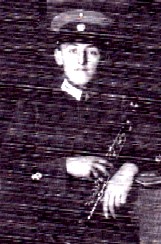 Josef's
younger brother, Ferdinand Hotwagner, a postman in Pinkafeld, was also arrested because he
donated money for the persecuted in Oberwart and Pinkafeld. Since he was previously a musician
in the Austrian Army, he was given a choice: either face trial or go into the Army again. He
opted for the Army and was assigned to a disciplinary unit; he was soon in Sarajevo, where he
died. Josef's
younger brother, Ferdinand Hotwagner, a postman in Pinkafeld, was also arrested because he
donated money for the persecuted in Oberwart and Pinkafeld. Since he was previously a musician
in the Austrian Army, he was given a choice: either face trial or go into the Army again. He
opted for the Army and was assigned to a disciplinary unit; he was soon in Sarajevo, where he
died.
Our historian, Josef, did not speak of the youngest brother, Adolph, but he was first reported
as missing in 1944 in Nikopol, Ukraine, where he served as part of the 3rd Gebirgejäger
(Mountain Fighters). It was later determined that he died there.
The above is why historian Josef became interested in exploring the Nazi crimes in Rechnitz
during WW-II. Not only did many Jewish prisoners die and his town was inexorably damaged by
the atrocity, but the people responsible also caused the deaths of his father and uncle... it
became personal, quite personal.

So, that is the rest of the story, a story left hidden by Beebe's minimal notes.
As for Maria's grandson, Josef Hotwagner, David Litchfield, author of an expose on Margit
Thyssen-Batthyány and her family's activities during and after WW-II, and who used Josef as a
source on the massacre, perhaps said it best in a commentary on his website:
We mourn the sad loss of Dr Josef Hotwagner of Rechnitz, who died yesterday [23 Sep
2010] surrounded by his family. We were extremely privileged to be able to call Josef our
friend since meeting him seven years ago and will always honour his memory. Our sympathies
go to his wife, Marie-Luise and his children, Eva and Eugen. The community of Rechnitz, the
county of Burgenland and the country of Austria have lost one of their very best. We mourn
their sad loss also.
And for Maria's sons Josef and Ferdinand, they paid the ultimate price for kindness to the
persecuted. To make matters worse—if such is possible—Maria also lost her last and youngest
child to the Nazi war. Sad, sad indeed.
|
 •
Son Josef Hotwagner was a teacher in Kitzladen, Austria, from 1928 until 1938. He died
in a prison hospital, July 3, 1945, in Straübing, Germany.
•
Son Josef Hotwagner was a teacher in Kitzladen, Austria, from 1928 until 1938. He died
in a prison hospital, July 3, 1945, in Straübing, Germany. News
News This
month's random bits and pieces (Article 1) begins with repeats of
requests for assistance, that being from the historian commissioned to create the 750th
anniversary volume for the municipality of Großpetersdorf and the 4 villages that are
part of it, Welgersdorf, Kleinpetersdorf, Kleinzicken and
Miedlingsdorf, and from a Master's student at Vienna University, who is doing a
research survey. I believe these are worthy projects that need your support. We follow
with the continuing saga of Austrian SPÖ politics... things are happening! Then we
provide an update on the Neusiedlersee water crisis in northern Burgenland. In the
fourth bit, we talk about an update to our recipes page. The last bit recounts some history,
but with a document to make it real.
This
month's random bits and pieces (Article 1) begins with repeats of
requests for assistance, that being from the historian commissioned to create the 750th
anniversary volume for the municipality of Großpetersdorf and the 4 villages that are
part of it, Welgersdorf, Kleinpetersdorf, Kleinzicken and
Miedlingsdorf, and from a Master's student at Vienna University, who is doing a
research survey. I believe these are worthy projects that need your support. We follow
with the continuing saga of Austrian SPÖ politics... things are happening! Then we
provide an update on the Neusiedlersee water crisis in northern Burgenland. In the
fourth bit, we talk about an update to our recipes page. The last bit recounts some history,
but with a document to make it real.
 Großpetersdorf
750th Anniversary Book: I recently received a request from Dr. Gerhard Baumgartner, a
historian from Vienna. He said that the municipality of Großpetersdorf will soon be
celebrating the 750th anniversary of its first documented existence, so wants to publish a
history of Großpetersdorf and the four villages belonging to it:
Welgersdorf, Kleinpetersdorf, Kleinzicken and
Miedlingsdorf. He has been commissioned to put together this volume (I have confirmed
this) and is looking for documents and photographs of all kinds of things relating to either
the history of the villages or the families that left for the USA, Canada, and South America.
Großpetersdorf
750th Anniversary Book: I recently received a request from Dr. Gerhard Baumgartner, a
historian from Vienna. He said that the municipality of Großpetersdorf will soon be
celebrating the 750th anniversary of its first documented existence, so wants to publish a
history of Großpetersdorf and the four villages belonging to it:
Welgersdorf, Kleinpetersdorf, Kleinzicken and
Miedlingsdorf. He has been commissioned to put together this volume (I have confirmed
this) and is looking for documents and photographs of all kinds of things relating to either
the history of the villages or the families that left for the USA, Canada, and South America. Vienna
University Student Needs Interview Subjects: Nikola Blagojevic, a Master's candidate
at Vienna University in the Department of Social and Cultural Anthropology,
needs digital interview subjects for a class project regarding Burgenland's natural
environment. I have confirmed that he is, in fact, a student there and that this is a
legitimate request. Therefore, I am asking you to assist him by participating. I will present
his request then add a few additional comments.
Vienna
University Student Needs Interview Subjects: Nikola Blagojevic, a Master's candidate
at Vienna University in the Department of Social and Cultural Anthropology,
needs digital interview subjects for a class project regarding Burgenland's natural
environment. I have confirmed that he is, in fact, a student there and that this is a
legitimate request. Therefore, I am asking you to assist him by participating. I will present
his request then add a few additional comments. While
there were 73 total applicants, only Andreas Babler, the Mayor of Traiskirchen, Lower Austria,
proved viable (and he is likely only trying to earn name recognition on the national stage
this time around). The other candidates could not get the required 30 declarations of support,
were not party members, or failed to follow-up with the election committee.
While
there were 73 total applicants, only Andreas Babler, the Mayor of Traiskirchen, Lower Austria,
proved viable (and he is likely only trying to earn name recognition on the national stage
this time around). The other candidates could not get the required 30 declarations of support,
were not party members, or failed to follow-up with the election committee.


 The
Facebook Bunch (from Vanessa Sandhu):
The
Facebook Bunch (from Vanessa Sandhu): Update
for book "The Burgenländer Emigration to America": Here is this month's update on
purchases of the English issue of the 3rd edition of Dr. Walter Dujmovits' book "Die
Amerika-Wanderung Der Burgenländer."
Update
for book "The Burgenländer Emigration to America": Here is this month's update on
purchases of the English issue of the 3rd edition of Dr. Walter Dujmovits' book "Die
Amerika-Wanderung Der Burgenländer." Nine Eggs Cake
Nine Eggs Cake The
castle proper was completely destroyed when the Red Army overran the town and the
surrounding area during the night of 29 March 1945. Although the Russians were blamed for
setting the castle ablaze, many townspeople believe it was the German forces who torched it
in compliance with Hitler's scorched earth policy. The surviving private chapel suffered
the ignominy of being converted into a bar and other buildings into apartments.
The
castle proper was completely destroyed when the Red Army overran the town and the
surrounding area during the night of 29 March 1945. Although the Russians were blamed for
setting the castle ablaze, many townspeople believe it was the German forces who torched it
in compliance with Hitler's scorched earth policy. The surviving private chapel suffered
the ignominy of being converted into a bar and other buildings into apartments.  What
I did not know when I wrote that text, is that much of the atrocity story is known due to the
research of Maria's grandson, Josef Hotwagner, who was 8 at the time. As you might expect, the
participants in the atrocity did their best to cover it up.
What
I did not know when I wrote that text, is that much of the atrocity story is known due to the
research of Maria's grandson, Josef Hotwagner, who was 8 at the time. As you might expect, the
participants in the atrocity did their best to cover it up.
 To
this day, the site of the final resting place of the bodies is unknown, though the shootings
took place at the Kreuzstadel (cross barn) on the edge of town, where a small group of
Jewish prisoners were forced to dig a large pit. Truckloads of additional prisoners were
brought there, forced to strip and kneel on the edge of the pit, then were shot in the neck by
party guests. The Kreuzstadel is now a monument to commemorate the massacre. However,
no mass grave has ever been found there, despite repeated research efforts.
To
this day, the site of the final resting place of the bodies is unknown, though the shootings
took place at the Kreuzstadel (cross barn) on the edge of town, where a small group of
Jewish prisoners were forced to dig a large pit. Truckloads of additional prisoners were
brought there, forced to strip and kneel on the edge of the pit, then were shot in the neck by
party guests. The Kreuzstadel is now a monument to commemorate the massacre. However,
no mass grave has ever been found there, despite repeated research efforts. Margit
Thyssen, who died in 1989, skipped off to Switzerland immediately after, and insufficient
evidence has been produced to prove that she participated. However, her nephew, Sacha
Batthyány, who knew her well, titles her a "monster" and says she loved shooting and horses
over everything else, even her own children. Sacha also wrote that, although the massacre was
known of within the family, it was not a subject that could ever be discussed, especially
since Margit controlled the family fortune.
Margit
Thyssen, who died in 1989, skipped off to Switzerland immediately after, and insufficient
evidence has been produced to prove that she participated. However, her nephew, Sacha
Batthyány, who knew her well, titles her a "monster" and says she loved shooting and horses
over everything else, even her own children. Sacha also wrote that, although the massacre was
known of within the family, it was not a subject that could ever be discussed, especially
since Margit controlled the family fortune. The
historian Josef Hotwagner, son of the Josef above, and Wilhelm Gregorich
(see below) report the story more fully... Josef's father was the head of the primary school
in Kitzladen until 1938, but was demoted several times thereafter by the Nazi regime, largely
because he could speak Hungarian, first to St. Martin and then to Schachendorf as a simple
teacher.
The
historian Josef Hotwagner, son of the Josef above, and Wilhelm Gregorich
(see below) report the story more fully... Josef's father was the head of the primary school
in Kitzladen until 1938, but was demoted several times thereafter by the Nazi regime, largely
because he could speak Hungarian, first to St. Martin and then to Schachendorf as a simple
teacher. Meanwhile,
Wilhelm Gregorich, a teacher in Oberwart, spoke a few kind words at a funeral in memory of the
village priest, who had died shortly after the Anschluß. Wilhelm was reported as a
"friend of the church"—therefore as a Nazi opponent—and sent to a disciplinary unit in the
summer of 1938. By 1940, he was allowed to return as a teacher in Schandorf, but the teacher's
apartment was occupied so he moved to Rechnitz, where he got to know fellow teacher Josef
Hotwagner. One summer day in 1940, they were together and returning home from church when they
met Imre Kiss, a Nazi opponent. Imre was collecting money for the families of 30 men
incarcerated in Pinkafeld, saying that their wives and children have nothing. Gregorich and
Hotwagner each gave five marks. However, the transaction was observed and they were eventually
betrayed by another teacher.
Meanwhile,
Wilhelm Gregorich, a teacher in Oberwart, spoke a few kind words at a funeral in memory of the
village priest, who had died shortly after the Anschluß. Wilhelm was reported as a
"friend of the church"—therefore as a Nazi opponent—and sent to a disciplinary unit in the
summer of 1938. By 1940, he was allowed to return as a teacher in Schandorf, but the teacher's
apartment was occupied so he moved to Rechnitz, where he got to know fellow teacher Josef
Hotwagner. One summer day in 1940, they were together and returning home from church when they
met Imre Kiss, a Nazi opponent. Imre was collecting money for the families of 30 men
incarcerated in Pinkafeld, saying that their wives and children have nothing. Gregorich and
Hotwagner each gave five marks. However, the transaction was observed and they were eventually
betrayed by another teacher. Josef's
younger brother, Ferdinand Hotwagner, a postman in Pinkafeld, was also arrested because he
donated money for the persecuted in Oberwart and Pinkafeld. Since he was previously a musician
in the Austrian Army, he was given a choice: either face trial or go into the Army again. He
opted for the Army and was assigned to a disciplinary unit; he was soon in Sarajevo, where he
died.
Josef's
younger brother, Ferdinand Hotwagner, a postman in Pinkafeld, was also arrested because he
donated money for the persecuted in Oberwart and Pinkafeld. Since he was previously a musician
in the Austrian Army, he was given a choice: either face trial or go into the Army again. He
opted for the Army and was assigned to a disciplinary unit; he was soon in Sarajevo, where he
died. Josef
Weber, age 86, of North Haledon, New Jersey, passed away on Wednesday, April 5, 2023.
Josef
Weber, age 86, of North Haledon, New Jersey, passed away on Wednesday, April 5, 2023.